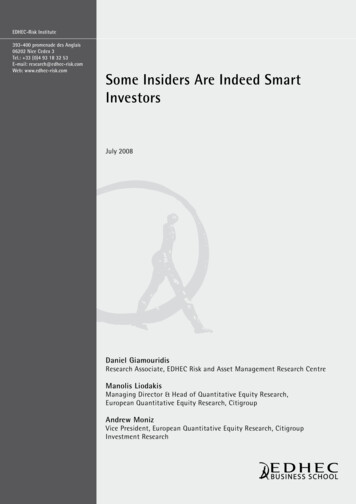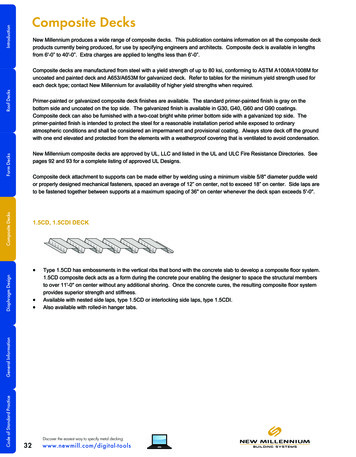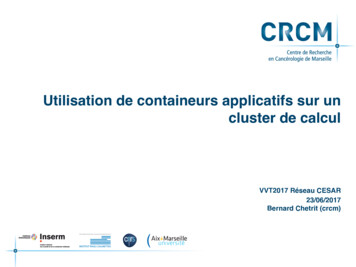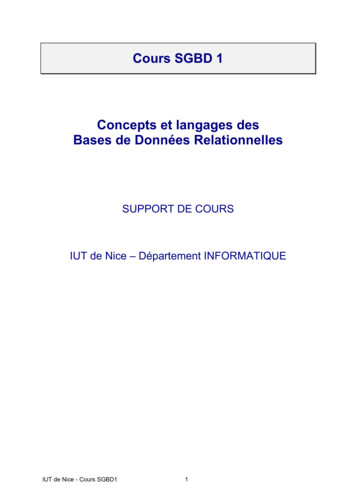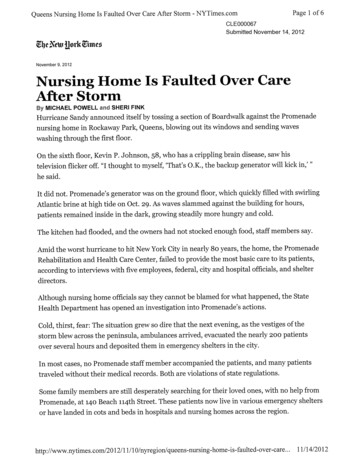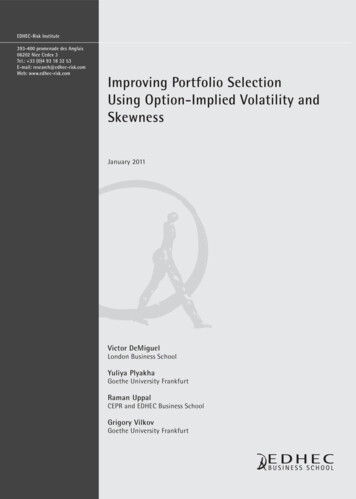
Transcription
EDHEC-Risk Institute393-400 promenade des Anglais06202 Nice Cedex 3Tel.: 33 (0)4 93 18 32 53E-mail: research@edhec-risk.comWeb: www.edhec-risk.comImproving Portfolio SelectionUsing Option-Implied Volatility andSkewnessJanuary 2011Victor DeMiguelLondon Business SchoolYuliya PlyakhaGoethe University FrankfurtRaman UppalCEPR and EDHEC Business SchoolGrigory VilkovGoethe University Frankfurt
AbstractOur objective in this paper is to examine whether one can use option-implied information toimprove the selection of portfolios with a large number of stocks, and to document which aspectsof option-implied information are most useful for improving their out-of-sample performance.Portfolio performance is measured in terms of four metrics: volatility, Sharpe ratio, certaintyequivalent return and turnover. Our empirical evidence shows that, while using option-impliedvolatility and correlation does not significantly improve the portfolio volatility, Sharpe ratio andcertainty-equivalent return, exploiting information contained in the volatility risk premium andoption-implied skewness substantially increases both the Sharpe ratio and certainty-equivalentreturn, although this is accompanied by higher turnover. Moreover, the volatility risk premiumand option-implied skewness help improve not just the performance of mean-variance portfolios,but also the performance of parametric portfolios developed in Brandt, Santa-Clara and Valkanov(2009).Keywords: mean variance, option-implied volatility, variance risk premium, option-impliedskewness, portfolio optimisationJEL: G11, G12, G13, G17We gratefully acknowledge financial support from Inquire-Europe. However, this articlerepresents the views of the authors and not those of Inquire. We also received helpful commentsand suggestions from Alexander Alekseev, Luca Benzoni, Michael Brandt, Mike Chernov, EngelbertDockner, Bernard Dumas, Wayne Ferson, Lorenzo Garlappi, Nicolae Gârleanu, Rene Garcia, AmitGoyal, Jakub Jurek, Nikunj Kapadia, Ralph Koijen, Vasant Naik, Stavros Panageas, Andrew Patton,Marcel Rindisbacher, Paulo Rodrigues, Pedro Santa-Clara, Christian Schlag, Bernd Scherer, GeorgeSkiadopoulos, Josef Zechner, and seminar participants at Goethe University Frankfurt, AHL (ManInvestments), London School of Economics, University of Mainz, University of Piraeus, ViennaUniversity of Economics and Business Administration, Duke-UNC Asset Pricing Conference,Financial Econometrics Conference at Toulouse School of Economics, and meetings of theWestern Finance Association.EDHEC is one of the top five business schools in France. Its reputation is built on the high qualityof its faculty and the privileged relationship with professionals that the school has cultivatedsince its establishment in 1906. EDHEC Business School has decided to draw on its extensiveknowledge of the professional environment and has therefore focused its research on themes thatsatisfy the needs of professionals.2EDHEC pursues an active research policy in the field of finance. EDHEC-Risk Institute carries outnumerous research programmes in the areas of asset allocation and risk management in both thetraditional and alternative investment universes.Copyright 2011 EDHEC
1. IntroductionTo determine the optimal portfolio of an investor, one needs to estimate the moments of assetreturns, such as means, volatilities and correlations. Traditionally, historical returns data has beenused for this estimation, but researchers have found that portfolios based on sample estimatesperform poorly out of sample.1 Several approaches have been proposed in literature for improvingthe performance of portfolios based on historical data.2In this paper, instead of trying to improve the quality of the moments estimated from historicaldata, we use forward-looking option-implied moments of stock-return distributions.3 Themain contribution of our work is to empirically demonstrate how one can use option-impliedinformation to improve portfolio selection with a large number of stocks, and to document whichaspects of option-implied information are particularly useful. Specifically, we study how one canuse option-implied volatility, correlation, skewness and the volatility risk premium to adjust thevolatility and correlation of stock returns in order to improve the out-of-sample performanceof static portfolios. We find that the improvement in portfolio performance from using optionimplied volatilities and correlations is small, contrary to what one may have expected. However,the use of option-implied skewness and the volatility risk premium can lead to substantialimprovements in Sharpe ratios and certainty-equivalent returns (even when shortsales areconstrained), but this is accompanied by an increase in portfolio turnover.It is well known that it is much more difficult to estimate expected returns than second momentsof stock returns (Merton, 1980), and, as a result, much recent research has focused on minimumvariance portfolios, which rely solely on estimates of covariances. In fact, Jagannathan and Ma(2003, 1652-1653) write that: "The estimation error in the sample mean is so large nothingmuch is lost in ignoring the mean altogether when no further information about the populationmean is available. For example, the global minimum variance portfolio has as large an out-ofsample Sharpe ratio as other efficient portfolios when past historical average returns are used asproxies for expected returns. In view of this, we focus our attention on global minimum varianceportfolios in this study." Just like Jagannathan and Ma (2003), we too focus on minimum-varianceportfolios. However, the methodology we develop also applies to mean-variance portfolios, toportfolios obtained from the maximisation of more general utility functions and to the parametricportfolios of Brandt, Santa-Clara and Valkanov (2009).To determine the minimum-variance portfolio, one needs to estimate each stock's volatility andits correlations with all the other stocks. We undertake our analysis in three steps. In step one,we determine the optimal portfolio using volatilities implified by option prices. In step two, wefind the optimal portfolio using correlations implied by option prices. In step three, we find theoptimal portfolio when volatilities are scaled based on option-implied skewness and the volatilityrisk premium. Below, we summarise below the findings from these three steps.In the first step, we find that using option-implied volatilities to compute the optimal portfoliodoes not lead to a substantial reduction in the out-of-sample portfolio volatility or to anincrease in the Sharpe ratio and certainty-equivalent return. This is surprising because thereis substancial literature documenting that implied volatility can predict stock-return volatilitybetter than sample volatility (see, for example, Blair, Poon and Taylor [2001] and Jiang and Tian[2005]). We explain that there are two reasons why option-implied volatility fails to improveportfolio performance. First, the implied volatilities are estimators with large variances becausethey are based exclusively on current option prices. Second, as the implied volatilities estimatethe risk-neutral volatilities, they are biased estimators of the real-world (objective) volatilities,with the gap between the two being the volatility risk premium, as explained in Chernov (2007).1 - For evidence of this poor performance, see DeMiguel, Garlappi, and Uppal (2009) and the references therein.2 - These approaches include: imposing a factor structure on returns (Chan, Karceski, and Lakonishok, 1999; MacKinlay and Pastor, 2000), using daily data rather than monthly data (Jagannathan and Ma,2003), using Bayesian methods (Jobson, Korkie, and Ratti, 1979; Jorion, 1986; Pastor, 2000; Pastor and Stambaugh, 2000; Ledoit and Wolf, 2004b), constraining shortsales (Jagannathan and Ma, 2003),constraining the norm of the vector of portfolio weights (DeMiguel, Garlappi, and Uppal, 2009), and using stock-return characteristics such as size, momentum, and the book-to-market ratio (Brandt,Santa-Clara, and Valkanov, 2009).3 - For other examples of the use of option-implied volatility and skewness, see Christoersen and Chang (2009), who use implied volatility and skewness to forecast future realised betas.3
However, we find that even the portfolios based on the risk-premium-corrected implied volatilitiesattain an out-of-sample portfolio volatility that is only about 5% lower than the traditionalportfolios based on the historical stock-return data, while the improvement in Sharpe ratio isstill insignificant.In the second step, we find that the benefits from using option-implied correlations are evensmaller than the gains from using option-implied volatilities. To understand the reason for this,note that the covariance matrix that improves portfolio performance will be the one that containsenough information about future covariances and is stable (with a small condition number and,correspondingly, less volatile portfolio weights). Our empirical results indicate that, while optionimplied volatilities and correlations are better than their historical counterparts at forecastingthe future realisations of these moments, the gains are not substantial enough to offset the lossfrom the increased instability of the covariance matrix-the effect of which is reflected in themuch higher portfolio turnover.Finally, in the third step, we study how two other sources of option-implied information canbe used to improve portfolio selection. The first is the historical volatility risk premium, andits choice is motivated by the empirical regularity documented by Bali and Hovakimian (2009)and Goyal and Saretto (2009) that assets with high volatility risk premia tend to outperformthose with low volatility risk premia. Our empirical evidence shows that portfolios based onvolatilities scaled by the volatility risk premia outperform traditional portfolios. The secondsource of information is option-implied skewness, whose choice is motivated by the finding inRehman and Vilkov (2009) that stocks with high option-implied skewness outperform stockswith low option-implied skewness.4 We find that portfolios that use volatilities scaled by impliedskewness achieve significantly higher Sharpe ratios than those of traditional portfolios (evenin the presence of shortsale constraints), but these gains are accompanied by higher portfolioturnover. The volatility risk premium and implied skewness improve the performance also ofthe Brandt, Santa-Clara, and Valkanov (2009) parametric portfolios, over and above the gainsobtained from using the "size" and "value" characteristics identified in Fama and French (1992),and "momentum" identified in Jegadeesh and Titman (1993).Our analysis is carried out in comprehensive fashion. We consider two data sets: with 100 assetsand 561 assets; two data frequencies: daily and intraday; two portfolio rebalancing periods:daily and monthly; four performance metrics: portfolio volatility, Sharpe ratio, certaintyequivalent return and turnover; and nine benchmark portfolios: the "1 N" equally-weightedportfolio sample-based mean-variance portfolio minimum-variance portfolio based on thesample covariance matrix shortsale-constrained minimum-variance portfolio; minimum-varianceportfolio with shrinkage of the covariance matrix minimum-variance portfolio with correlationsin the covariance matrix set equal to zero minimum-variance portfolio with correlations inthe covariance matrix set equal to the mean correlation across all asset pairs the parametricportfolios developed in Brandt, Santa-Clara and Valkanov (2009) and the portfolio based on themaximisation of expected utility.We conclude this introduction by discussing the relation of our work to the existing literature.The idea that option prices contain information about future asset returns has been understoodever since the work of Black and Scholes (1972) and Merton (1973).5 The focus of our work isto investigate how the information implied by option prices can be used to improve portfolioselection. There are two other papers that study this. The first, by Aït-Sahalia and Brandt (2008),uses option-implied state prices to solve the intertemporal consumption and portfolio choice44 - For the relation between expected stock returns and skewness measured directly, as opposed to option-implied skewness, see Rubinstein (1973), Kraus and Litzenberger (1976), Harvey and Siddique(2000), and Boyer, Mitton, and Vorkink (2009).5- For example, Latane and Rendleman (1976), Lamoureux and Lastrapes (1993), and Christensen and Prabhala (1998) find that implied volatility outperforms historical volatility in forecasting futurevolatility, and Poon and Granger (2005) provide a comprehensive survey of this literature. Bakshi, Kapadia, and Madan (2003) explain how one can use option prices to infer also higher moments of thereturn distribution, such as skewness. Driessen, Maenhout, and Vilkov (2009) show, in the working paper version of their article, how one can also obtain implied correlations from the prices of options onindividual stocks and on the index, while Bali and Hovakimian (2009), Bollerslev, Tauchen, and Zhou (2008), Cremers and Weinbaum (2008), Goyal and Saretto (2009), Rehman and Vilkov (2009), and Xing,Zhang, and Zhao (2009) show that options can also be used to forecast future returns of the underlying asset. Of course, one can extract not just particular moments of returns, but also the probabilitydistribution function, as shown by Jackwerth and Rubinstein (1996), Aït-Sahalia and Lo (1998), Jackwerth (2000), Bliss and Panigirtzoglou (2004), Panigirtzoglou and Skiadopoulos (2004), and Benzoni (1998),while Chernov and Ghysels (2000) show how to estimate jointly both the objective measure and the risk-neutral measure.
problem, using the Cox and Huang (1989) martingale representation formulation, rather than theMerton (1971) dynamic-programming formulation. This paper finds that optimal consumptionand portfolio rules based on option-implied information are different from those obtained usingstandard return dynamics. However, its focus is not on finding the optimal portfolio with superiorout-of-sample performance. The second, which is by Kostakis, Panigirtzoglou, and Skiadopoulos(2009), studies the asset-allocation problem of allocating wealth between the S&P500 index anda riskless asset. The paper uses options on the index to first back out the implied risk-neutraldistribution of returns and then transforms this to the objective distribution. This paper findsthat the out-of-sample performance of the portfolio based on this distribution is better thanthat of a portfolio based on the historical distribution. However, there is an important differencebetween this work and ours: rather than considering the problem of how to allocate wealthbetween the S&P500 index and the risk-free asset, we consider the portfolio-selection problem ofallocating wealth across a large number of individual stocks; in particular, we consider portfolioswith 100 stocks and 561 stocks. It is not clear how one would extend the methodology ofKostakis, Panigirtzoglou and Skiadopoulos (2009) to accommodate a large number of risky assets.They also need to make other restrictive assumptions, such as the existence of a representativeinvestor and the completeness of financial markets, which are not required in our analysis.The rest of the paper is divided into a number of short, distinct sections. In Section 2, we providea brief background to the portfolio selection problem. In Section 3, we describe the data onstock returns and options that we use. In Section 4, we explain the performance metrics we useto evaluate portfolios. The construction and performance of our benchmark portfolios that donot use option-implied information are described in Section 5. How we compute the quantitiesimplied by option prices that we use for portfolio selection is explained in Section 6. Our mainfindings about the performance of various portfolios that use option-implied informationare given in Section 7. The robustness checks we undertake are described in Section 8 and weconclude in Section 9. Appendix A explains how to compute variances and covariances for highfrequency intraday data; Appendix B describes the method used for shrinkage and regularisationof the covariance matrix; and Appendix C explains the construction of model-free option-impliedmoments.2. Portfolio Selection ProblemThe classic mean-variance optimisation problem can be written as(1)(2)whereis the vector of portfolio weights invested in stocks,is the estimatedcovariance matrix, γ is the investor's risk aversion,is the estimated vector of expectedreturns andis the vector of ones. The objective in (1) is to minimise the differencebetween the variance of the portfolio return,, and its mean,, after taking intoaccount the risk aversion of the agent. The constraint 1 in (2) ensures that the portfolioweights sum to one. We consider the case without the risk-free asset because our objective is toexplore how to use option-implied information to select the portfolio of risky stocks.In light of our discussion in the introduction about the difficulty in forecasting expected returns,we assume all expected returns to be equal to the same constant,. Then the meanvariance objective in (1) reduces to minimising the variance of the portfolio return:(3)5
subject to the constraint in (2). The solution to the above problem is:Note that the covariance matrixmatrices,(4)in (4) can be decomposed into volatility and correlation(5)where diag ( ) denotes the diagonal matrix with volatilities of the stocks on the diagonal, andis the correlation matrix. Thus, to obtain the optimal portfolio weights in (4) there are twoquantities that need to be estimated: volatilities ( ) and correlations . We will use informationimplied by prices of options to estimate both quantities.3. DataIn this section, we describe the data on stocks and stock options that we use in our study. Ourdata on stocks is from the Center for Research in Security Prices (CRSP) and NYSE's Trades-AndQuotes (TAQ) database. To implement the parametric portfolio policies, we also use data fromCompustat. Our data for options is from IvyDB (OptionMetrics).3.1 Data on Stock ReturnsOur sample period is January 3, 1995, to June 29, 2007. We study stocks that are in the S&P500index at any time during our sample period. The daily stock returns of the S&P500 constituentsis from the daily file of the CRSP, and we have in our sample a total of 3,146 trading days.We also use high-frequency intraday stock-price data consisting of transaction prices of theS&P500 constituents; these data are from the NYSE's TAQ database. We use the intraday databecause several studies have highlighted the advantage of using high-frequency data to measurevolatility of financial returns, and also as a robustness check for the results obtained from dailydata.6To improve the quality of the raw data used in our analysis, we apply the following filters and datacleaning rules. For the daily stock returns of the S&P500 constituents from the CRSP daily file, weremove the observations with standard missing codes (SAS missing codes A,B,C,D and E) as described inthe Wharton Research Data Services documentation on CRSP. For the intraday stock-price raw data, wefilter data for each day from the offcial opening at 9:30 EST until 16:00 EST, and delete entries with: abid, ask, or transaction price equal to zero; corrected trades (trades with a correction indicator, "corr" 6 0); an abnormal sale condition (trades where the variable "cond" has a letter code, except for "E" and"F")7; and prices that are above the ask plus the bid-ask spread or prices that are below the bid minus thebid-ask spread. See Barndor-Nielsen, Hansen, Lunde, and Shephard (2009) for the details and discussionof these rules.8 After cleaning the data, we construct a regularly spaced one-minute price grid for everytrading day using the volume-weighted average of all transactions within a given minute. If there is noprice for a given minute, we fill it in with the previous available price.Counting by IvyDB (OptionMetrics) identifiers, we have data for a maximum of 810 stocks, fromwhich we choose those stocks for which at least 2,000 records of intraday volatilities and modelfree implied volatilities are available, which gives us 561 stocks. Of these 561 stocks, there are 219stocks for which the intraday volatilities and model-free implied volatilities are available for theentire time series. For robustness, we consider two datasets in our analysis. The first consists of all561 stocks,9 and the second consists of 100 stocks out of the 219 for which data are available for alldates; to select these 100 stocks, we first order the 219 stocks with respect to the security identiercode of IvyDB, and then select the first 100.1066 - For a survey of the literature on using high-frequency data to estimate moments of asset returns, see Andersen, Bollerslev and Diebold (2009).7 - See the TAQ 3 Users Guide for additional details about sale conditions.8 - See rules P1, P2, T1, T2 and an adjusted version of T4.9 - At each point in time, we consider only those stocks that have no missing data, which means that this sample has a variable number of stocks; on average, there are about 400 stocks at each point in time.10 - In addition to the reported results, we have also checked our results on dierent subsamples of 50 and 100 stocks out of the 219 for which data are available for all dates, and these subsamples deliver similarresults; details of this are provided in Section 8.1.
3.2 Data on Stock OptionsFor stock options we use IvyDB that contains data on all U.S.-listed index and equity options.We use data from January 4, 1996, to June 29, 2007.11While we do not use option prices directly in our analysis, we wish to use option-basedinformation only to obtain the moments of the option-implied distributions, and for this reasonit is important for us to have the maximum number of options for a given maturity. Therefore,we choose for our analysis not the raw data on prices of options, but the volatility surface file,which contains a smoothed implied-volatility surface for a range of standard maturities and aset of option delta points.12From the surface file we select for our sample the out-of-the-money implied volatilities forcalls and puts (we take implied volatilities for calls with deltas smaller or equal to 0:5, andimplied volatilities for puts with deltas bigger than -0:5) for standard maturities of 30 and 60days, which we consider to be the most suitable.13 For each date, underlying stock, and time tomaturity, we have from the surface data 13 implied volatilities, which are then used to calculatethe moments of the risk-neutral distribution.14When working with data on option prices and the volatility surface, for several calculations weneed a proxy for the riskfree rate for the maturity of a particular option. For this, we use thecerticate-of-deposit yields for maturities between one day and one year from the IvyDB andinterpolate them linearly to get the appropriate yield.3.3 Data on Stock CharacteristicsFor our analysis of the Brandt, Santa-Clara and Valkanov (2009) parametric portfolios, wemeasure size (market value of equity) as the price of the stock per share multiplied by sharesoutstanding; both variables are obtained from the CRSP database. For measuring value, wefirst use the Compustat Quarterly Fundamentals le (from 1994 to 2008) to calculate the bookvalue of equity, which is total assets (ACTQ) minus liabilities (LCTQ) minus preferred/preferencestock — redeemable (PSTKRQ) plus deferred taxes and investment tax credit (TXDITCQ), andthen divide the book equity by the market value of equity computed earlier. The three-monthmomentum characteristic is measured using daily returns data from CRSP. To get betterdistributional properties of the constructed characteristics, we take the logarithm of size andvalue characteristics. 154. Description of Portfolio-Performance MetricsWe evaluate performance of the various portfolios using four criteria. These are the (i) outof- sample portfolio volatility (standard deviation); (ii) out-of-sample portfolio Sharpe ratio;(iii) out-of-sample portfolio certainty-equivalent return; and (iv) portfolio turnover (tradingvolume). The reason for using the certainty-equivalent return, in addition to the Sharpe ratio,is that the Sharpe ratio only considers the mean and volatility of returns, while the certaintyequivalent return also considers the higher moments of returns.We use the following "rolling-horizon" procedure for computing the portfolio weights andevaluating their performance. First, we choose a window over which to perform the estimation.We denote the length of the estimation window by τ T, where T is the total number of returnsin the dataset. For our experiments, we use an estimation window of τ 750 data points forthe sample with 561 stocks, and τ 250 data points for the sample with 100 stocks, which for11 - Note that our data for stocks start in 1995, but we need 750 data points to compute the covariance matrix, so our portfolio optimisation starts only at the beginning of 1998.12 - We calculated implied moments also from the raw data on option prices, and the results are similar.13 - The use of out-of-the-money options is standard in this literature; see, for instance, Bakshi, Kapadia, and Madan (2003) and Carr and Wu (2009). The reason is that selecting options that are out of themoney reduces the effect of the premium for early exercise for these American options.14 - There are 13 implied volatilities given for standard delta points for each call and put. For puts, these 13 deltas are {—0:80, —0:75, —0:70, —0:65, —0:60, —0:55, —0:50, —0:45, —0:40, —0:35, —0:30, —0:25,—0:20}, and for calls the delta points are the same, but positive. We select calls with a delta less than or equal to 0:5 and for puts greater than —0:5, which gives a total of 13 implied volatilities for out-ofthe-money options a mix of calls and puts.15 - In order to prepare these characteristics so that they can be used to compute the parametric portfolio weights, we also winsorize the characteristics by assigning the value of the 3rd percentile to allvalues below the 3rd percentile and do the same for values higher than the 97th percentile. And we normalise all characteristics to have zero mean and unit standard deviation.7
daily data corresponds to three years and one year, respectively.16 Second, using the return dataover the estimation window τ, we compute the various portfolios we wish to compare. Third, werepeat this "rolling-window" procedure for the next day, by including the data for the next dayand dropping the data for the earliest day. We continue doing this until the end of the datasetis reached. At the end of this process, we have generated T — τ portfolio-weight vectors for eachstrategy; that is,for t τ, , T — 1 and for each strategy.We consider two rebalancing intervals: daily and monthly. For the monthly rebalancing interval, wefind the new set of weights daily, but hold that portfolio for 30 calendar days (21 trading days),which corresponds to the average of 21 daily returns; the advantage of this approach for monthlyrebalancing is that it is not sensitive to the particular day on which the portfolio is formed.Following this "rolling-horizon" methodology, holding the portfoliofor one day (orfor one month, when we consider a monthly holding period) gives the out-of-sample returnat time t 1: that is,; where rt 1 denotes the returns from t tot 1. After collecting the time series of T - τ returns,, the out-of-sample mean, volatility(b), Sharpe ratio of returns (SR), and certainty-equivalent return (ce) are:(6)(7)(8)(9)where u denotes the power utility function with a relative risk aversion of γ 1, and thecertainty-equivalent return (ce) is the riskless return that an investor is willing to accept insteadof investing in the risky strategy.To measure the statistical significance of the difference in the volatility, Sharpe ratio, andcertainty-equivalent return of a particular portfolio from that of another portfolio that servesas a benchmark, we report also the p-values for these differences. For calculating the p-valuesfor the case of daily rebalancing we use the bootstrapping methodology described in Efron andTibshirani (1993), and for monthly rebalancing we make an additional adjustment, as in Politisand Romano (1994), to account for the auto-correlation arising from overlapping returns.17Finally, we wish to obtain a measure of portfolio turnover. Letdenote the portfolioweight in stock j chosen at time t under strategy strategy,the portfolio weight beforerebalancing but at t 1, andthe desired portfolio weight at time t 1 (after rebalancing).Then, turnover, which is the average percentage of wealth traded per rebalancing interval (dailyor monthly), is defined as the sum of the absolute value of the rebalancing trades across the Navailable stocks and over the T — τ —1 trading dates, normalised by the total number of tradingdates:Turnover .(10)816 - Because our samples consists of 561 stocks and 100 stocks, estimation window lengths shorter than τ 750 for the data with 561 stocks and shorter than τ 250 for the data with 100 stocks oftengive singularities in the covariance matrix.17 - Specifically, consider two portfolios i and n, with µi, µn, σi, σn as their true means and volatilities. We wish to test the hypothesis that the Sharpe ratio (or certainty-equivalent return) of portfolio i isworse (smaller) than that of the benchmark portfolio n, that is,. To do this, we obtain B pairs of size T- τ of the portfolio returns i and n by simple resampling with replacement for dailyreturns, and by blockwise resampling with replacement f
3 - For other examples of the use of option-implied volatility and skewness, see Christoersen and Chang (2009), who use implied volatility and skewness to forecast future realised betas. 4 However, we find that even the portfolios based on the risk-premium-corrected implied volatilities
